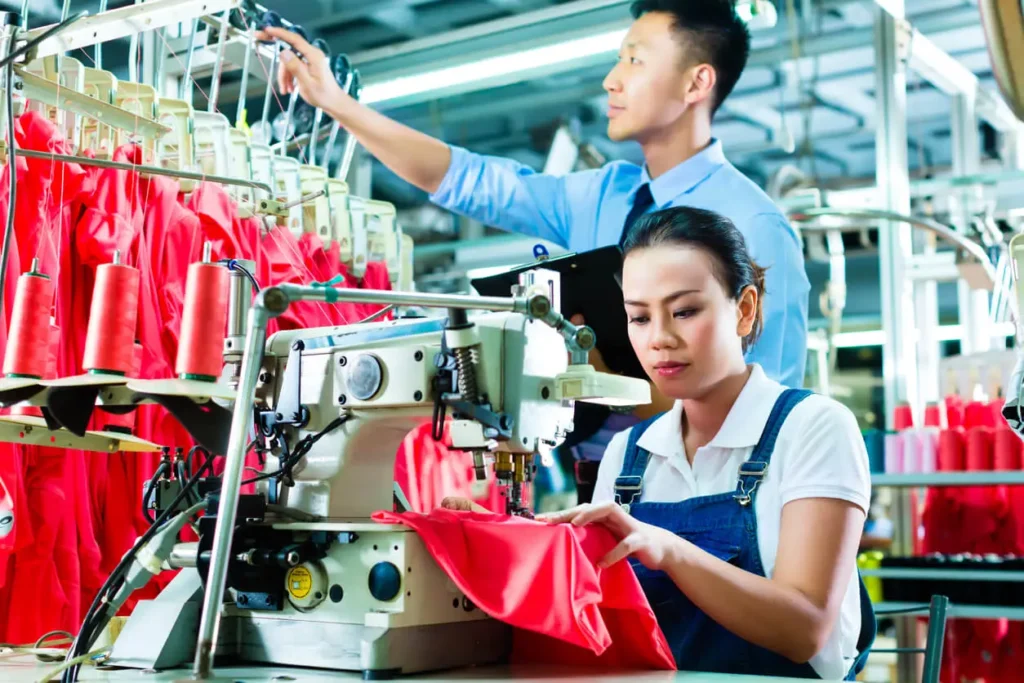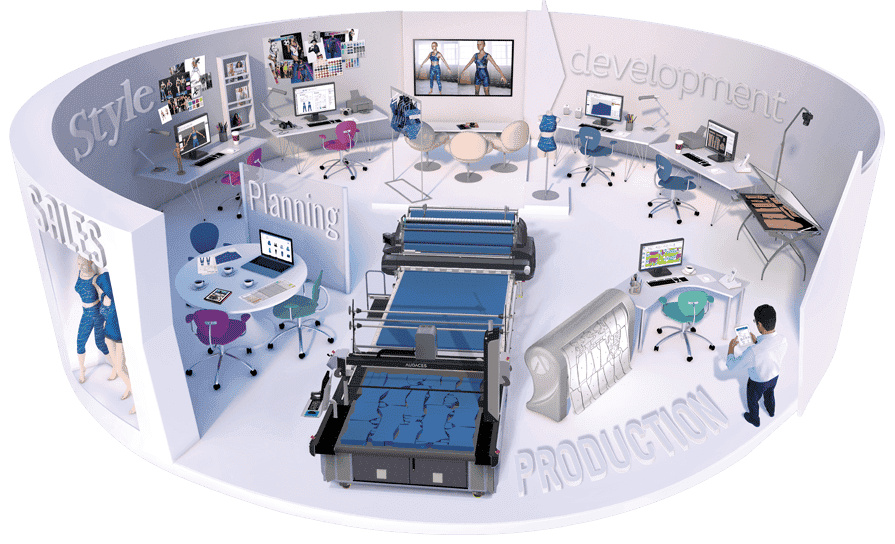Summary
- PPC stands for Production Planning and Control and is an essential management tool for manufacturing companies.
- It ensures that all activities run efficiently and that each process is delivered on time.
- Technology plays the main role in production planning. Streamline your fashion processes today, try Audaces360 for free!
Manufacturing a product is a complex endeavor, encompassing a multitude of variables and people. From employees and suppliers to raw materials, quantities, and deadlines, the intricacies involved can be overwhelming.
Thankfully, Production Planning and Control (PPC) in manufacturing helps to streamline operations. Businesses can achieve the desired outcomes while minimizing costs.
For this reason, we created a guide to explain the benefits of Production Planning and Control. It will also provide you with information on how to use it effectively in your company.
Enjoy your reading!
Sumário
Why is PPC for fashion manufacturing so important?
In a process that involves as many steps as apparel manufacturing, knowing the right flow to follow is key. PPC for manufacturing is a way to determine that everyone knows what to do. And most importantly — how and when.
It ensures a well-organized and optimized production process. Clearly defining and monitoring each step minimizes bottlenecks and keeps garments moving through production efficiently.
Here are some of the results business owners and production managers can achieve:
- Smooth production flow: PPC bridges the gap between design and production and establishes a schedule.
- Resource optimization: the planning optimizes the use of resources like materials, labor, and machinery.
- Quality assurance: it ensures quality checks in different stages, allowing for early detection of issues.
- On-time delivery: scheduling production guarantees an efficient supply chain and the delivery of items to customers on time.
- Competitive advantage: a well-run PPC system leads to increased efficiency and lower production costs.
Learn more: What is PPC and its importance in fashion manufacturing?
How does PPC work for fashion manufacturing?
Some crucial elements of PPC for manufacturing ensure efficiency, quality, and timely delivery of finished goods.
Product quantity determination
Capacity planning is the first step to building a robust production strategy. Knowing your entire production line helps you determine how many items you can deliver in a specific time frame.
Stipulating the exact quantity requires careful consideration of various factors, including the number of employees, supplier capacity, and available machinery.
By implementing PPC for manufacturing, you gain access to insightful reports that empower you to enhance your competitive edge.
One strategy is outsourcing a part of the production process. You can use it regularly in your company or temporarily during busy times in the market.
This information is crucial for acquiring new customers and boosting profits. It helps you avoid two adverse scenarios that no manufacturing company desires:
- Not producing enough and failing to utilize your full production potential.
- Taking on excess orders and becoming overwhelmed, leading to customer frustration.
Learn more: Understand how to do fabric consumption calculation for your collection
Factory floor layout
Whether you are new or an established company — PPC for manufacturing can help optimize your factory floor layout.
PPC facilitates new businesses in defining the optimal placement of machinery and workstations based on your planned production sequence.
This ensures a smooth flow of materials from one stage to the next, minimizing backtracking and delays.
It also promotes safety and ergonomics, promoting a safe and comfortable working environment for your employees.
In existing operations, PPC provides valuable insights to identify potential stages that slow down overall results.
By understanding these bottlenecks, you can adjust your layout to improve flow. For instance, redesigning the layout to minimize worker travel distances.
Learn more: How to eliminate 10 common problems in the cutting room
Defining manufacturing steps

PPC helps break down complex manufacturing operations into individual and manageable steps. Reports help you analyze the entire production sequence from raw material acquisition to finished product delivery.
Separating the process into small steps allows for a clear view of each stage and its role in overall production.
Once you divide the process, PPC helps identify and sequence the specific tasks in the most efficient order. With this information, you can start creating standards.
Clear procedures and instructions for each task ensure consistency in production quality and reduce the risk of errors.
They also simplify training for new employees and help everyone involved understand their roles and responsibilities.
Learn more: 5 strategies to optimize your production with efficient fashion
Workforce selection
Ok, by now you have learned your production capacity, designed the factory floor layout, and defined each stage. It is time to recruit the appropriate workforce!
Analyze the defined manufacturing process steps to identify the specific skills and knowledge required. This includes understanding the equipment used, the materials handled, and the quality control procedures.
This way you can target your recruitment efforts to attract candidates with specific abilities for optimal production efficiency. It reduces the time and resources spent on training or hiring people who may not be a good fit for the specific tasks.
Pay attention to having the right number of employees. The goal is to avoid situations where you have understaffing or overstaffing, which will negatively impact costs.
Matching employees with tasks that align with their skills and capabilities leads to increased employee satisfaction. When employees feel competent, they tend to work happier and with greater motivation.
Learn more: 4 key steps to streamline your fashion production process
How to implement PPC in your fashion manufacturing?

Dive deep into every stage
Having successfully defined the various stages of your PPC for manufacturing operations, delve deeper into each one, ensuring a seamless implementation.
Establish a clear hierarchy of roles within the teams. Assigning responsibilities to each member ensures accountability and promotes efficient delegation.
You also must focus on choosing appropriate software that aligns with the specific needs of your business. This may include ERP (Enterprise Resource Planning) and PLM (Product Lifecycle Management) solutions.
Together, they integrate product data, streamlining design, production, and inventory management.
The next step is to define clear procedures for daily factory operations, including material administration and production order sequencing.
Align it with an inventory management strategy. It will optimize stock levels, minimize carrying costs, and ensure adequate inventory to meet demand.
Finally, keep monitoring processes to ensure adherence to plans and identify areas for improvement. Collect data on production performance, resource usage, and quality metrics.
Learn more: How can your apparel business integrate PLM and ERP?
Perform Aggregate Production Planning (APP)
Aggregate Production Planning (APP) can be an ally in PPC for manufacturing. It involves defining production strategies for a specific timeframe, typically ranging from 3 to 18 months.
The aim is to balance supply and demand, ensuring that production capacity aligns with predicted demand. All while minimizing costs and inventory carrying expenses.
This information composes a comprehensive document that serves as a roadmap for production activities. It typically includes the following key information:
- Monthly stock and production volume: it outlines the planned production quantities and inventory levels for each month.
- Production capacity for the period: it details the maximum production output achievable given the available resources.
- Processes based on the supply chain: it describes the specific production processes involved in manufacturing the products.
- Financial information: it provides essential financial data related to production activities, including unit costs, contracts with suppliers, and logistics expenses.
Monitor production in real time
By real-time monitoring, you can allocate resources effectively to areas that require more attention or experience delays.
Real-time tracking also enables better communication between departments, allowing for faster problem-solving and proactive decision-making.
It allows for immediate identification of quality issues at any stage of production. You can take corrective actions promptly, minimizing waste and rework costs.
The data reunited after some weeks of operation using PPC for manufacturing can provide valuable insights. Look closely to recognize quality trends and areas for improvement. This facilitates data-driven adjustments to quality control procedures and preventative measures.
Leverage technology to enhance PPC for manufacturing!

Audaces360
This is the only multi-solution available in the fashion technology market! It integrates tools to streamline different stages of your creation and production process, becoming a valuable partner when implementing PPC for manufacturing.
Our comprehensive system includes a solution to enhance your designs with digital technical drawings. You can even automatically generate pre-cost and tech packs in the same interface, using Audaces Idea.
Additionally, you can create digital garments with simulations of colors, textures, drapes, and patterns using Audaces Fashion Studio.
Both solutions rely on the assistance of Audaces Sofia. Our fashion Artificial Intelligence will help boost your inspiration and creativity by generating designs with simple commands.
You can also digitize your paper pattern in just a click with absolute precision with Audaces Digiflash solution. Meanwhile, Audaces Isa will help you manage your collections with a fashion PLM.
Design your patterns directly in the digital realm with Audaces Pattern. Seamlessly integrate them and create markings using Audaces Marker. Audaces Supera then takes over, maximizing efficiency by managing marking queues.
Download our free e-book and keep learning about our solutions for apparel manufacturing!
FAQ
In a process that involves as many steps as apparel manufacturing, knowing the right flow to follow is key. PPC for manufacturing is a way to determine that everyone knows what to do. And most importantly — how and when.
Some crucial elements of PPC for manufacturing ensure efficiency, quality, and timely delivery. They include product quantity determination, factory floor layout, defining manufacturing steps, and workforce selection.
Dive deep into every stage, perform Aggregate Production Planning (APP), and monitor production in real time.










